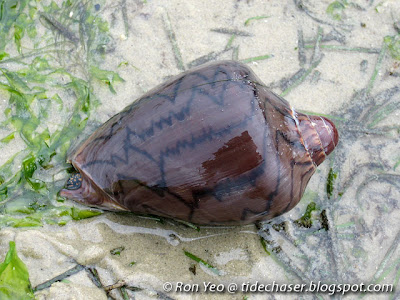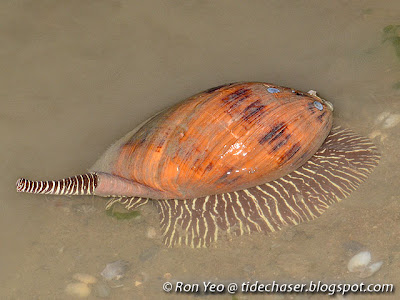The volutes are large snails with a short spire, and most species have no operculum. The large foot usually comes with obvious patterns and colours, and they have a long siphon. They are carnivorous, and the ones in Singapore feed on other snails and clams. They can burrow to seek for their prey with their long siphon. Upon finding the prey, they will wrap their foot around it, and wait for the clam or snail to open up or emerge. They will then use their radula to feed on the prey. Unlike many marine snails, the eggs of the volutes hatch directly into small snails and not planktonic larvae. Many of these snails are collected for food and for making decorative items.
Here are some of the volutes that I have seen on our shores. You may want to take a look at my diagram on the parts of a snail's shell if you are not familiar with the names of the parts, so as to better understand the terms used below.

The Noble Volute (Cymbiola nobilis) is commonly seen on our shores at areas with sandy substrates for them to burrow. The shell is solid and heavy, with a short spire and a rounded apex. The shell can be light or dark brown or brownish orange, with axial zigzag lines of a darker colour. Some specimens have darker spiral bands around the shell, while others may not.

Here's a Noble Volute with a darker shell, but lacks the darker spiral bands. They can have beige shells with the zigzag lines but without the spiral bands too.

It lacks an operculum, and the body is dark purple to black with orange spots and blotches.

Some specimens may be badly eroded or overgrown with encrusting organisms, such as algae, and hence the patterns on the shell cannot be seen. They can be seen laying eggs sometimes. The eggs capsules are translucent, containing several embryos.

It is observed that the Noble Volute may not lay all the egg capsules at one time. Within the same cluster, one can find older egg capsules with dull colours, covered with sediment, and also newer egg capsules that are white and translucent. The above photo also shows the mother snail burrowing into the sand after laying a batch of egg capsules.

The metamorphosis occurs within the egg, and the young emerges as juvenile crawling snails, unlike most other marine snail species that hatch as planktonic larvae. Newly hatched snails are usually of a dark purple or dark brown, forming the patterns as they grow bigger.
Noble volutes have been observed to feed on smaller snails and clams. They are sometimes collected for food.

The Baler Shell (Melo melo) is another volute that can be found in Singapore. It is less commonly seen, and prefers soft substrates. This huge snail can grow to almost 30cm long! The oval shell is usually of a light brown, sometimes with darker spiral bands around the inflated body whorl. It has an almost flattened spire, with the apex sometimes depressed beneath the body whorl.

The body is brown with yellowish stripes. They are also called Melon Shells for their rounded shells with dark bands, resembling melons. Locals use their huge shell to bale water, and hence the common name "Baler Shell".

Baler Shells also lack an operculum. They have been observed to feed on other snails, and on one occasion, I have seen a Baler Shell hunting a smaller Noble Volute. They are often collected for food.
References
Here are some of the volutes that I have seen on our shores. You may want to take a look at my diagram on the parts of a snail's shell if you are not familiar with the names of the parts, so as to better understand the terms used below.

The Noble Volute (Cymbiola nobilis) is commonly seen on our shores at areas with sandy substrates for them to burrow. The shell is solid and heavy, with a short spire and a rounded apex. The shell can be light or dark brown or brownish orange, with axial zigzag lines of a darker colour. Some specimens have darker spiral bands around the shell, while others may not.

Here's a Noble Volute with a darker shell, but lacks the darker spiral bands. They can have beige shells with the zigzag lines but without the spiral bands too.

It lacks an operculum, and the body is dark purple to black with orange spots and blotches.

Some specimens may be badly eroded or overgrown with encrusting organisms, such as algae, and hence the patterns on the shell cannot be seen. They can be seen laying eggs sometimes. The eggs capsules are translucent, containing several embryos.

It is observed that the Noble Volute may not lay all the egg capsules at one time. Within the same cluster, one can find older egg capsules with dull colours, covered with sediment, and also newer egg capsules that are white and translucent. The above photo also shows the mother snail burrowing into the sand after laying a batch of egg capsules.

The metamorphosis occurs within the egg, and the young emerges as juvenile crawling snails, unlike most other marine snail species that hatch as planktonic larvae. Newly hatched snails are usually of a dark purple or dark brown, forming the patterns as they grow bigger.
Noble volutes have been observed to feed on smaller snails and clams. They are sometimes collected for food.

The Baler Shell (Melo melo) is another volute that can be found in Singapore. It is less commonly seen, and prefers soft substrates. This huge snail can grow to almost 30cm long! The oval shell is usually of a light brown, sometimes with darker spiral bands around the inflated body whorl. It has an almost flattened spire, with the apex sometimes depressed beneath the body whorl.

The body is brown with yellowish stripes. They are also called Melon Shells for their rounded shells with dark bands, resembling melons. Locals use their huge shell to bale water, and hence the common name "Baler Shell".

Baler Shells also lack an operculum. They have been observed to feed on other snails, and on one occasion, I have seen a Baler Shell hunting a smaller Noble Volute. They are often collected for food.
References
- Carpenter, K. E. and V. H. Niem (eds). 1998-2001. FAO species identification guide for fishery purposes. The living marine resources of the Western Central Pacific. Volumes 1 to 6. FAO, Rome. pp. 1-4218.
- Gladys Archerd Shell Collection at Washington State University Tri-Cities Natural History Museum. 2008. Retrieved September 26, 2012, from http://shells.tricity.wsu.edu/ArcherdShellCollection/ShellCollection.html.
- Oliver, A. P. H. 2012. Philip's guide to seashells of the world. Philip's, London. 320 pp.
- Tan, K. S. & L. M. Chou, 2000. A guide to common seashells of Singapore. Singapore Science Centre, Singapore. 168 pp.
- Tan, S. K. & H. P. M. Woo, 2010. A preliminary checklist of the molluscs of Singapore. Raffles Museum of Biodiversity Research, National University of Singapore, Singapore. 78 pp. Uploaded 02 June 2010.
- World Register of Marine Species. 2012. Retrieved Oct 3, 2012, from http://www.marinespecies.org.

No comments:
Post a Comment